Investigating HRM Practices and Employee Performance in UK Banks
VerifiedAdded on 2022/08/12
|8
|1455
|22
Report
AI Summary
This report presents a research methodology for investigating the impact of HRM practices on employee performance within the UK banking sector. The study outlines the research method, which includes both qualitative and quantitative approaches. The research design will be descriptive, aiming to gather detailed information. Data collection methods involve primary and secondary sources, including surveys with employees and interviews with bank managers. The sampling method utilizes random sampling. Data analysis will employ both quantitative techniques, using Likert scales, charts, and graphs, and qualitative techniques, involving thematic analysis. Ethical considerations, such as data security and privacy, are addressed. The report details the methodologies used, including data collection, sampling, and analysis techniques, as well as ethical considerations to ensure the integrity and validity of the research.
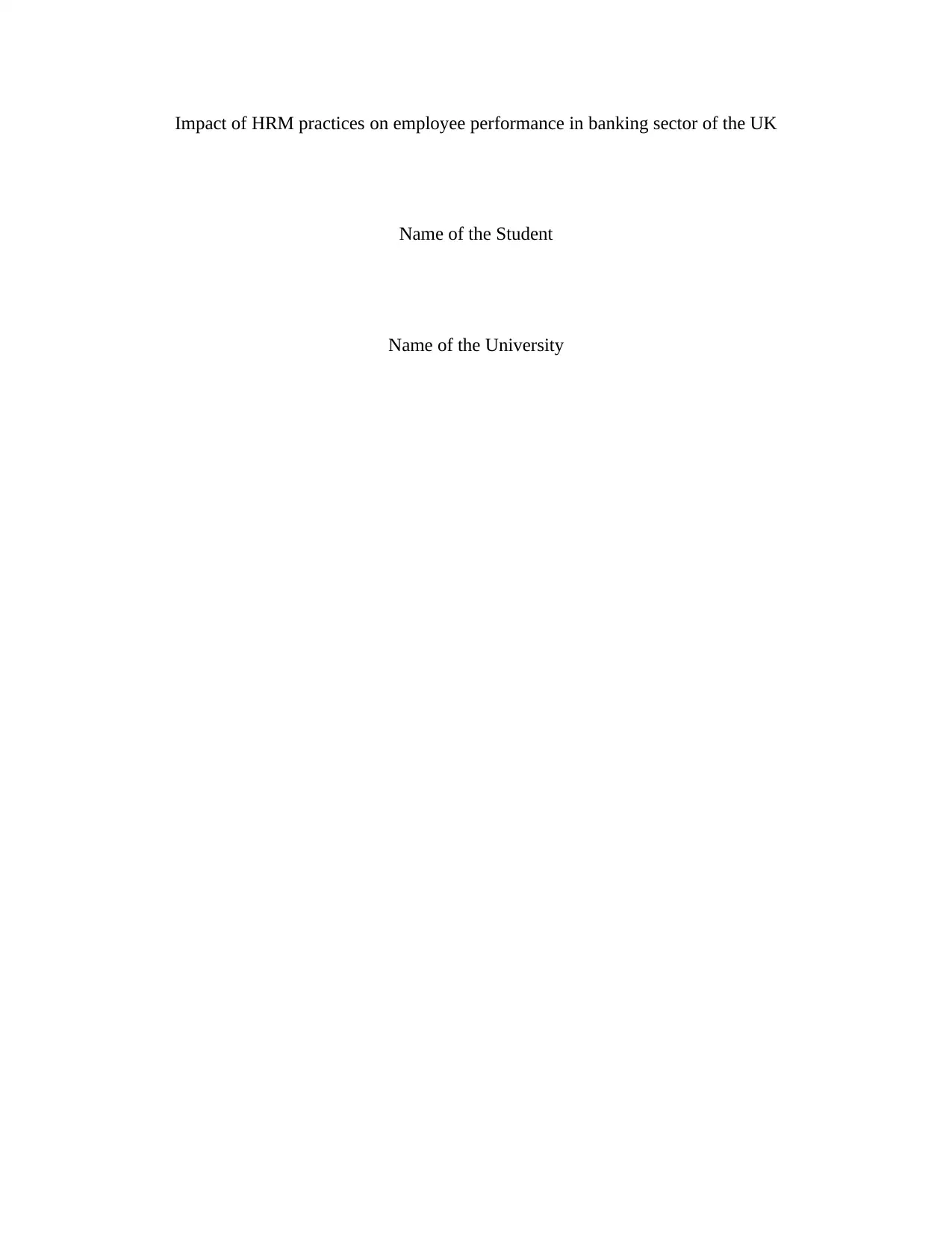
Impact of HRM practices on employee performance in banking sector of the UK
Name of the Student
Name of the University
Name of the Student
Name of the University
Paraphrase This Document
Need a fresh take? Get an instant paraphrase of this document with our AI Paraphraser
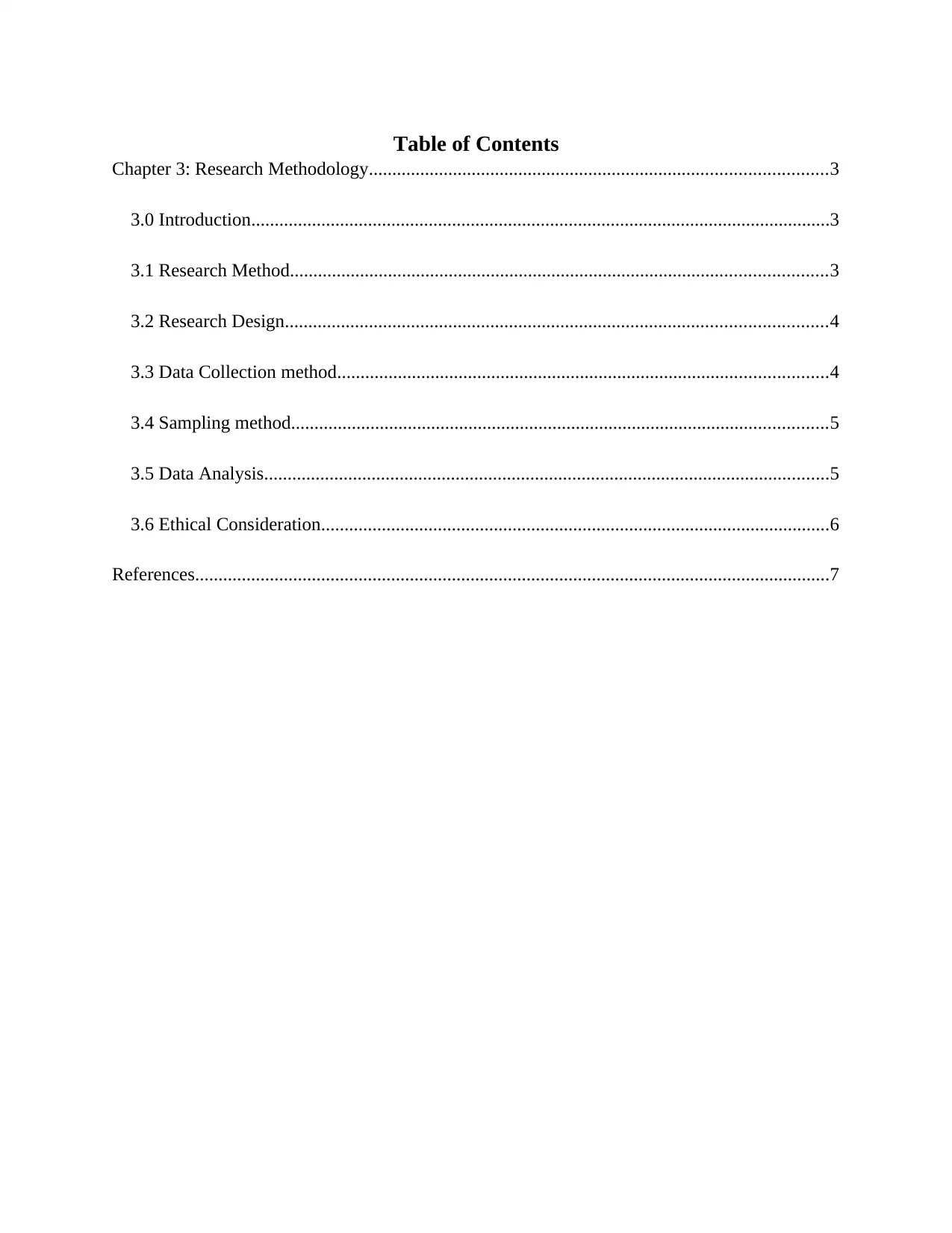
Table of Contents
Chapter 3: Research Methodology..................................................................................................3
3.0 Introduction............................................................................................................................3
3.1 Research Method...................................................................................................................3
3.2 Research Design....................................................................................................................4
3.3 Data Collection method.........................................................................................................4
3.4 Sampling method...................................................................................................................5
3.5 Data Analysis.........................................................................................................................5
3.6 Ethical Consideration.............................................................................................................6
References........................................................................................................................................7
Chapter 3: Research Methodology..................................................................................................3
3.0 Introduction............................................................................................................................3
3.1 Research Method...................................................................................................................3
3.2 Research Design....................................................................................................................4
3.3 Data Collection method.........................................................................................................4
3.4 Sampling method...................................................................................................................5
3.5 Data Analysis.........................................................................................................................5
3.6 Ethical Consideration.............................................................................................................6
References........................................................................................................................................7
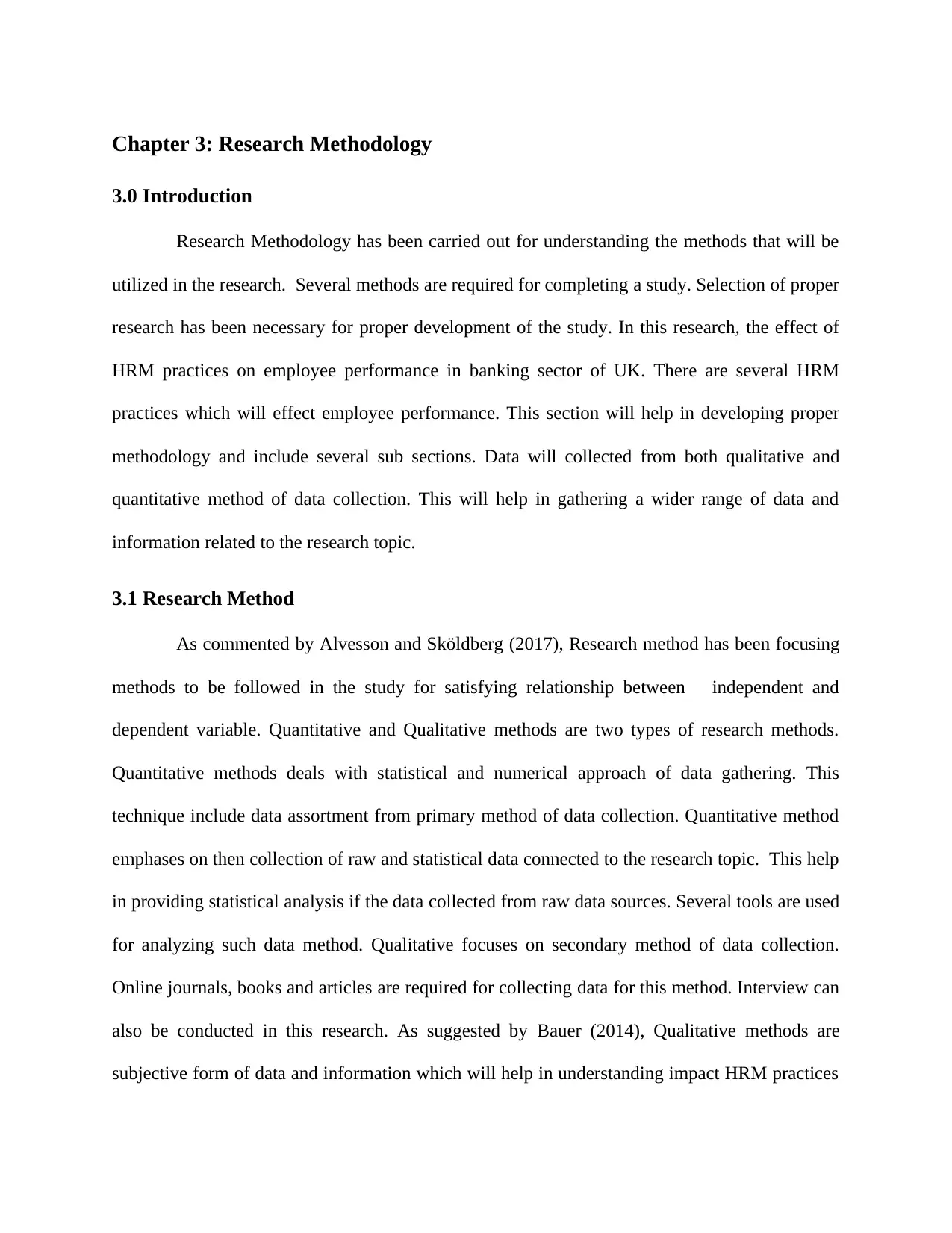
Chapter 3: Research Methodology
3.0 Introduction
“Research Methodology has been carried out for understanding the methods that will be
utilized in the research. Several methods are required for completing a study. Selection of proper
research has been necessary for proper development of the study. In this research, the effect of
HRM practices on employee performance in banking sector of UK. There are several HRM
practices which will effect employee performance. This section will help in developing proper
methodology and include several sub sections. Data will collected from both qualitative and
quantitative method of data collection. This will help in gathering a wider range of data and
information related to the research topic.”
3.1 Research Method
“As commented by Alvesson and Sköldberg (2017), Research method has been focusing
methods to be followed in the study for satisfying relationship between independent and
dependent variable. Quantitative and Qualitative methods are two types of research methods.
Quantitative methods deals with statistical and numerical approach of data gathering. This
technique include data assortment from primary method of data collection. Quantitative method
emphases on then collection of raw and statistical data connected to the research topic. This help
in providing statistical analysis if the data collected from raw data sources. Several tools are used
for analyzing such data method. Qualitative focuses on secondary method of data collection.
Online journals, books and articles are required for collecting data for this method. Interview can
also be conducted in this research. As suggested by Bauer (2014), Qualitative methods are
subjective form of data and information which will help in understanding impact HRM practices
3.0 Introduction
“Research Methodology has been carried out for understanding the methods that will be
utilized in the research. Several methods are required for completing a study. Selection of proper
research has been necessary for proper development of the study. In this research, the effect of
HRM practices on employee performance in banking sector of UK. There are several HRM
practices which will effect employee performance. This section will help in developing proper
methodology and include several sub sections. Data will collected from both qualitative and
quantitative method of data collection. This will help in gathering a wider range of data and
information related to the research topic.”
3.1 Research Method
“As commented by Alvesson and Sköldberg (2017), Research method has been focusing
methods to be followed in the study for satisfying relationship between independent and
dependent variable. Quantitative and Qualitative methods are two types of research methods.
Quantitative methods deals with statistical and numerical approach of data gathering. This
technique include data assortment from primary method of data collection. Quantitative method
emphases on then collection of raw and statistical data connected to the research topic. This help
in providing statistical analysis if the data collected from raw data sources. Several tools are used
for analyzing such data method. Qualitative focuses on secondary method of data collection.
Online journals, books and articles are required for collecting data for this method. Interview can
also be conducted in this research. As suggested by Bauer (2014), Qualitative methods are
subjective form of data and information which will help in understanding impact HRM practices
⊘ This is a preview!⊘
Do you want full access?
Subscribe today to unlock all pages.

Trusted by 1+ million students worldwide
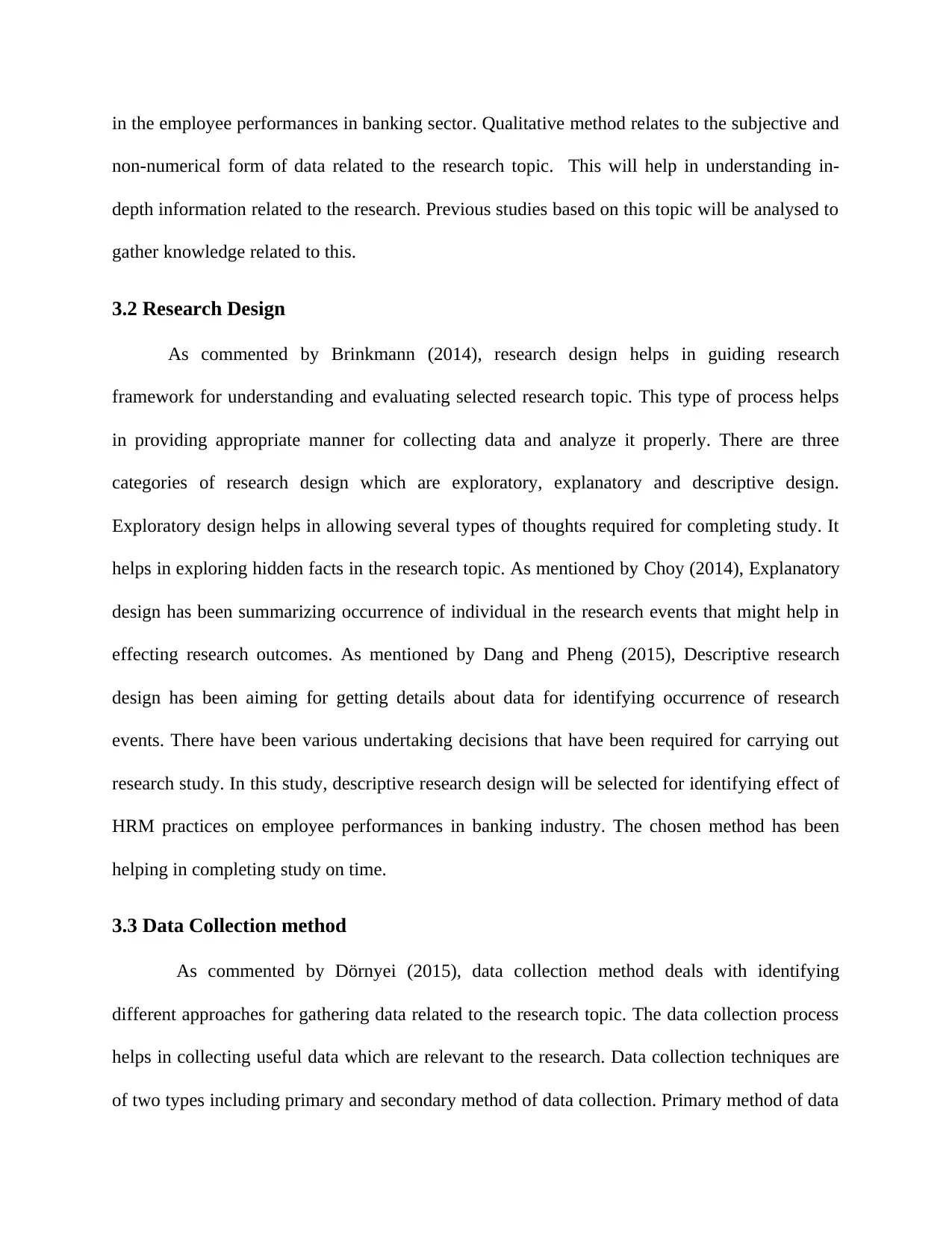
in the employee performances in banking sector. Qualitative method relates to the subjective and
non-numerical form of data related to the research topic. This will help in understanding in-
depth information related to the research. Previous studies based on this topic will be analysed to
gather knowledge related to this.”
3.2 Research Design
As commented by Brinkmann (2014), research design helps in guiding research
framework for understanding and evaluating selected research topic. This type of process helps
in providing appropriate manner for collecting data and analyze it properly. There are three
categories of research design which are exploratory, explanatory and descriptive design.
Exploratory design helps in allowing several types of thoughts required for completing study. It
helps in exploring hidden facts in the research topic. As mentioned by Choy (2014), Explanatory
design has been summarizing occurrence of individual in the research events that might help in
effecting research outcomes. As mentioned by Dang and Pheng (2015), Descriptive research
design has been aiming for getting details about data for identifying occurrence of research
events. There have been various undertaking decisions that have been required for carrying out
research study. In this study, descriptive research design will be selected for identifying effect of
HRM practices on employee performances in banking industry. The chosen method has been
helping in completing study on time.
3.3 Data Collection method
“As commented by Dörnyei (2015), data collection method deals with identifying
different approaches for gathering data related to the research topic. The data collection process
helps in collecting useful data which are relevant to the research. Data collection techniques are
of two types including primary and secondary method of data collection. Primary method of data
non-numerical form of data related to the research topic. This will help in understanding in-
depth information related to the research. Previous studies based on this topic will be analysed to
gather knowledge related to this.”
3.2 Research Design
As commented by Brinkmann (2014), research design helps in guiding research
framework for understanding and evaluating selected research topic. This type of process helps
in providing appropriate manner for collecting data and analyze it properly. There are three
categories of research design which are exploratory, explanatory and descriptive design.
Exploratory design helps in allowing several types of thoughts required for completing study. It
helps in exploring hidden facts in the research topic. As mentioned by Choy (2014), Explanatory
design has been summarizing occurrence of individual in the research events that might help in
effecting research outcomes. As mentioned by Dang and Pheng (2015), Descriptive research
design has been aiming for getting details about data for identifying occurrence of research
events. There have been various undertaking decisions that have been required for carrying out
research study. In this study, descriptive research design will be selected for identifying effect of
HRM practices on employee performances in banking industry. The chosen method has been
helping in completing study on time.
3.3 Data Collection method
“As commented by Dörnyei (2015), data collection method deals with identifying
different approaches for gathering data related to the research topic. The data collection process
helps in collecting useful data which are relevant to the research. Data collection techniques are
of two types including primary and secondary method of data collection. Primary method of data
Paraphrase This Document
Need a fresh take? Get an instant paraphrase of this document with our AI Paraphraser
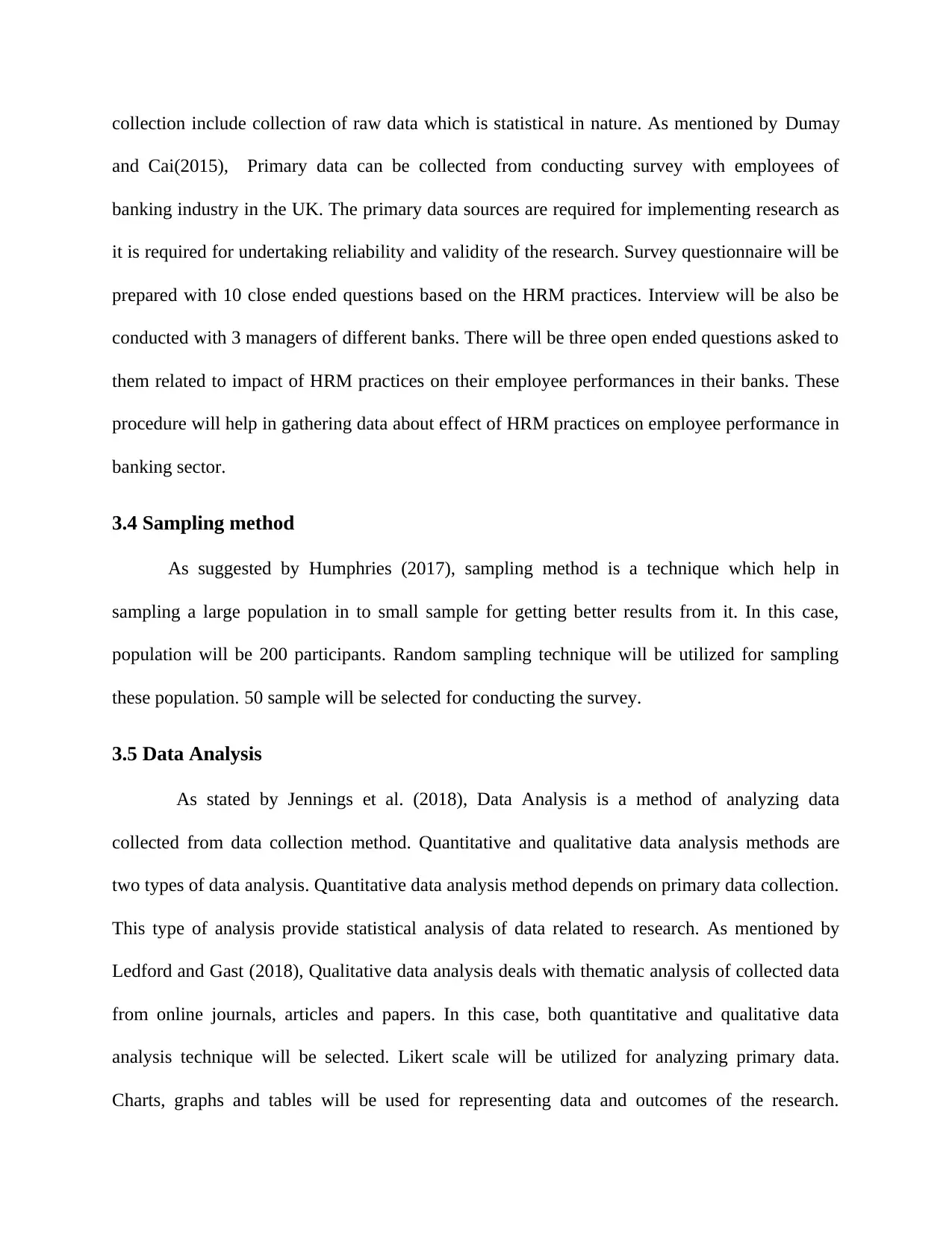
collection include collection of raw data which is statistical in nature. As mentioned by Dumay
and Cai(2015), Primary data can be collected from conducting survey with employees of
banking industry in the UK. The primary data sources are required for implementing research as
it is required for undertaking reliability and validity of the research. Survey questionnaire will be
prepared with 10 close ended questions based on the HRM practices. Interview will be also be
conducted with 3 managers of different banks. There will be three open ended questions asked to
them related to impact of HRM practices on their employee performances in their banks. These
procedure will help in gathering data about effect of HRM practices on employee performance in
banking sector.”
3.4 Sampling method
As suggested by Humphries (2017), sampling method is a technique which help in
sampling a large population in to small sample for getting better results from it. In this case,
population will be 200 participants. Random sampling technique will be utilized for sampling
these population. 50 sample will be selected for conducting the survey.
3.5 Data Analysis
“As stated by Jennings et al. (2018), Data Analysis is a method of analyzing data
collected from data collection method. Quantitative and qualitative data analysis methods are
two types of data analysis. Quantitative data analysis method depends on primary data collection.
This type of analysis provide statistical analysis of data related to research. As mentioned by
Ledford and Gast (2018), Qualitative data analysis deals with thematic analysis of collected data
from online journals, articles and papers. In this case, both quantitative and qualitative data
analysis technique will be selected. Likert scale will be utilized for analyzing primary data.
Charts, graphs and tables will be used for representing data and outcomes of the research.
and Cai(2015), Primary data can be collected from conducting survey with employees of
banking industry in the UK. The primary data sources are required for implementing research as
it is required for undertaking reliability and validity of the research. Survey questionnaire will be
prepared with 10 close ended questions based on the HRM practices. Interview will be also be
conducted with 3 managers of different banks. There will be three open ended questions asked to
them related to impact of HRM practices on their employee performances in their banks. These
procedure will help in gathering data about effect of HRM practices on employee performance in
banking sector.”
3.4 Sampling method
As suggested by Humphries (2017), sampling method is a technique which help in
sampling a large population in to small sample for getting better results from it. In this case,
population will be 200 participants. Random sampling technique will be utilized for sampling
these population. 50 sample will be selected for conducting the survey.
3.5 Data Analysis
“As stated by Jennings et al. (2018), Data Analysis is a method of analyzing data
collected from data collection method. Quantitative and qualitative data analysis methods are
two types of data analysis. Quantitative data analysis method depends on primary data collection.
This type of analysis provide statistical analysis of data related to research. As mentioned by
Ledford and Gast (2018), Qualitative data analysis deals with thematic analysis of collected data
from online journals, articles and papers. In this case, both quantitative and qualitative data
analysis technique will be selected. Likert scale will be utilized for analyzing primary data.
Charts, graphs and tables will be used for representing data and outcomes of the research.
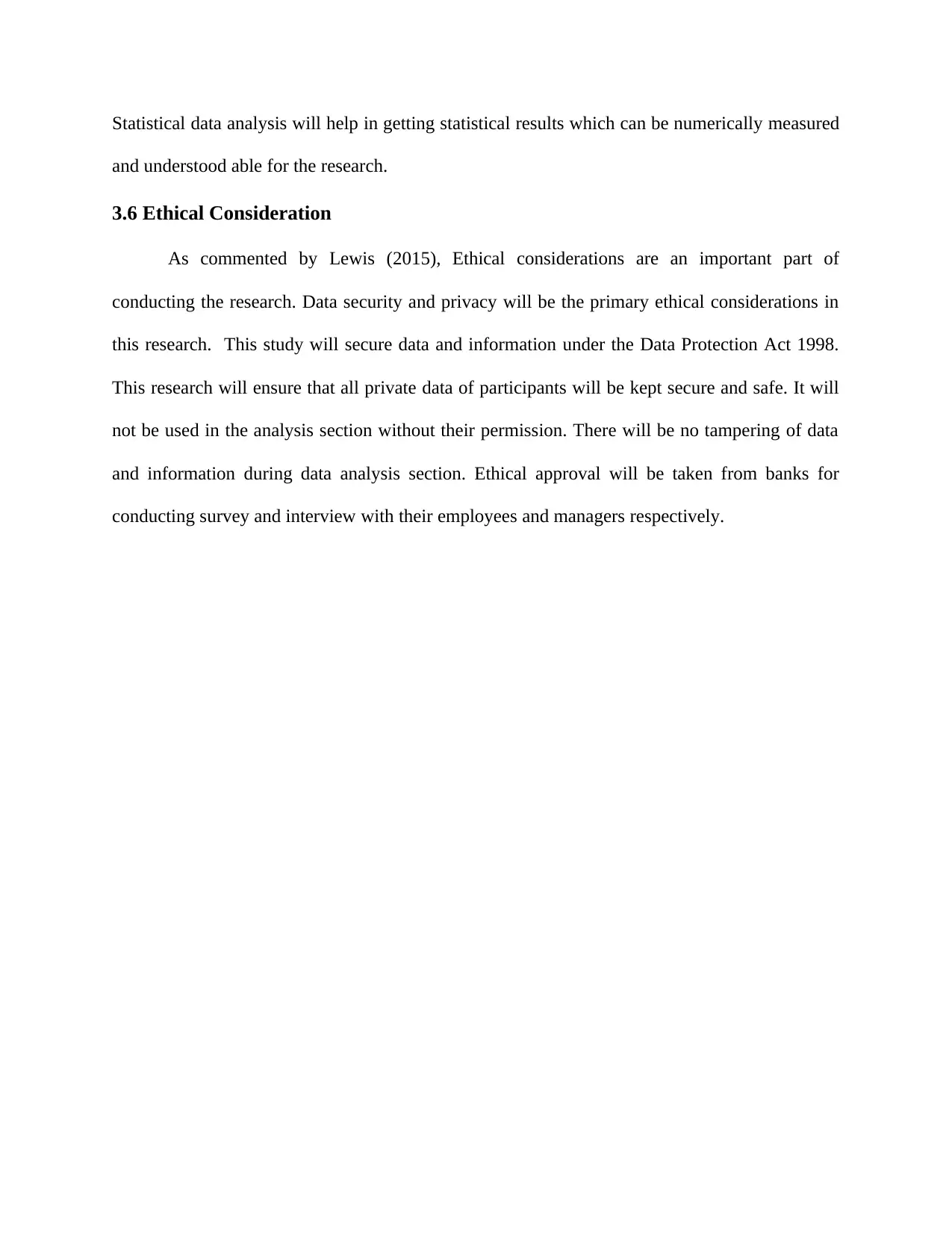
Statistical data analysis will help in getting statistical results which can be numerically measured
and understood able for the research.”
3.6 Ethical Consideration
As commented by Lewis (2015), Ethical considerations are an important part of
conducting the research. Data security and privacy will be the primary ethical considerations in
this research. This study will secure data and information under the Data Protection Act 1998.
This research will ensure that all private data of participants will be kept secure and safe. It will
not be used in the analysis section without their permission. There will be no tampering of data
and information during data analysis section. Ethical approval will be taken from banks for
conducting survey and interview with their employees and managers respectively.
and understood able for the research.”
3.6 Ethical Consideration
As commented by Lewis (2015), Ethical considerations are an important part of
conducting the research. Data security and privacy will be the primary ethical considerations in
this research. This study will secure data and information under the Data Protection Act 1998.
This research will ensure that all private data of participants will be kept secure and safe. It will
not be used in the analysis section without their permission. There will be no tampering of data
and information during data analysis section. Ethical approval will be taken from banks for
conducting survey and interview with their employees and managers respectively.
⊘ This is a preview!⊘
Do you want full access?
Subscribe today to unlock all pages.

Trusted by 1+ million students worldwide
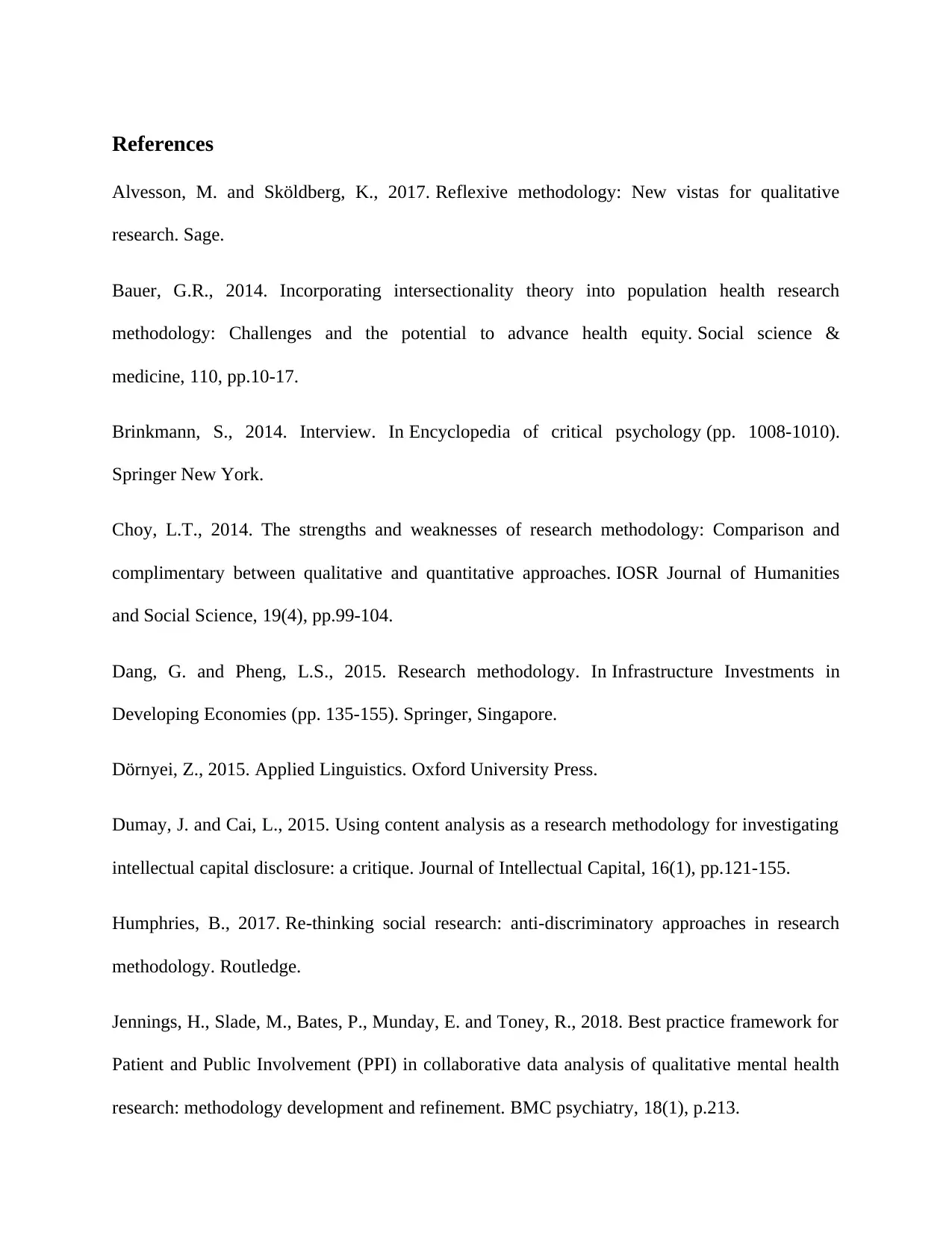
References
Alvesson, M. and Sköldberg, K., 2017. Reflexive methodology: New vistas for qualitative
research. Sage.
Bauer, G.R., 2014. Incorporating intersectionality theory into population health research
methodology: Challenges and the potential to advance health equity. Social science &
medicine, 110, pp.10-17.
Brinkmann, S., 2014. Interview. In Encyclopedia of critical psychology (pp. 1008-1010).
Springer New York.
Choy, L.T., 2014. The strengths and weaknesses of research methodology: Comparison and
complimentary between qualitative and quantitative approaches. IOSR Journal of Humanities
and Social Science, 19(4), pp.99-104.
Dang, G. and Pheng, L.S., 2015. Research methodology. In Infrastructure Investments in
Developing Economies (pp. 135-155). Springer, Singapore.
Dörnyei, Z., 2015. Applied Linguistics. Oxford University Press.
Dumay, J. and Cai, L., 2015. Using content analysis as a research methodology for investigating
intellectual capital disclosure: a critique. Journal of Intellectual Capital, 16(1), pp.121-155.
Humphries, B., 2017. Re-thinking social research: anti-discriminatory approaches in research
methodology. Routledge.
Jennings, H., Slade, M., Bates, P., Munday, E. and Toney, R., 2018. Best practice framework for
Patient and Public Involvement (PPI) in collaborative data analysis of qualitative mental health
research: methodology development and refinement. BMC psychiatry, 18(1), p.213.
Alvesson, M. and Sköldberg, K., 2017. Reflexive methodology: New vistas for qualitative
research. Sage.
Bauer, G.R., 2014. Incorporating intersectionality theory into population health research
methodology: Challenges and the potential to advance health equity. Social science &
medicine, 110, pp.10-17.
Brinkmann, S., 2014. Interview. In Encyclopedia of critical psychology (pp. 1008-1010).
Springer New York.
Choy, L.T., 2014. The strengths and weaknesses of research methodology: Comparison and
complimentary between qualitative and quantitative approaches. IOSR Journal of Humanities
and Social Science, 19(4), pp.99-104.
Dang, G. and Pheng, L.S., 2015. Research methodology. In Infrastructure Investments in
Developing Economies (pp. 135-155). Springer, Singapore.
Dörnyei, Z., 2015. Applied Linguistics. Oxford University Press.
Dumay, J. and Cai, L., 2015. Using content analysis as a research methodology for investigating
intellectual capital disclosure: a critique. Journal of Intellectual Capital, 16(1), pp.121-155.
Humphries, B., 2017. Re-thinking social research: anti-discriminatory approaches in research
methodology. Routledge.
Jennings, H., Slade, M., Bates, P., Munday, E. and Toney, R., 2018. Best practice framework for
Patient and Public Involvement (PPI) in collaborative data analysis of qualitative mental health
research: methodology development and refinement. BMC psychiatry, 18(1), p.213.
Paraphrase This Document
Need a fresh take? Get an instant paraphrase of this document with our AI Paraphraser
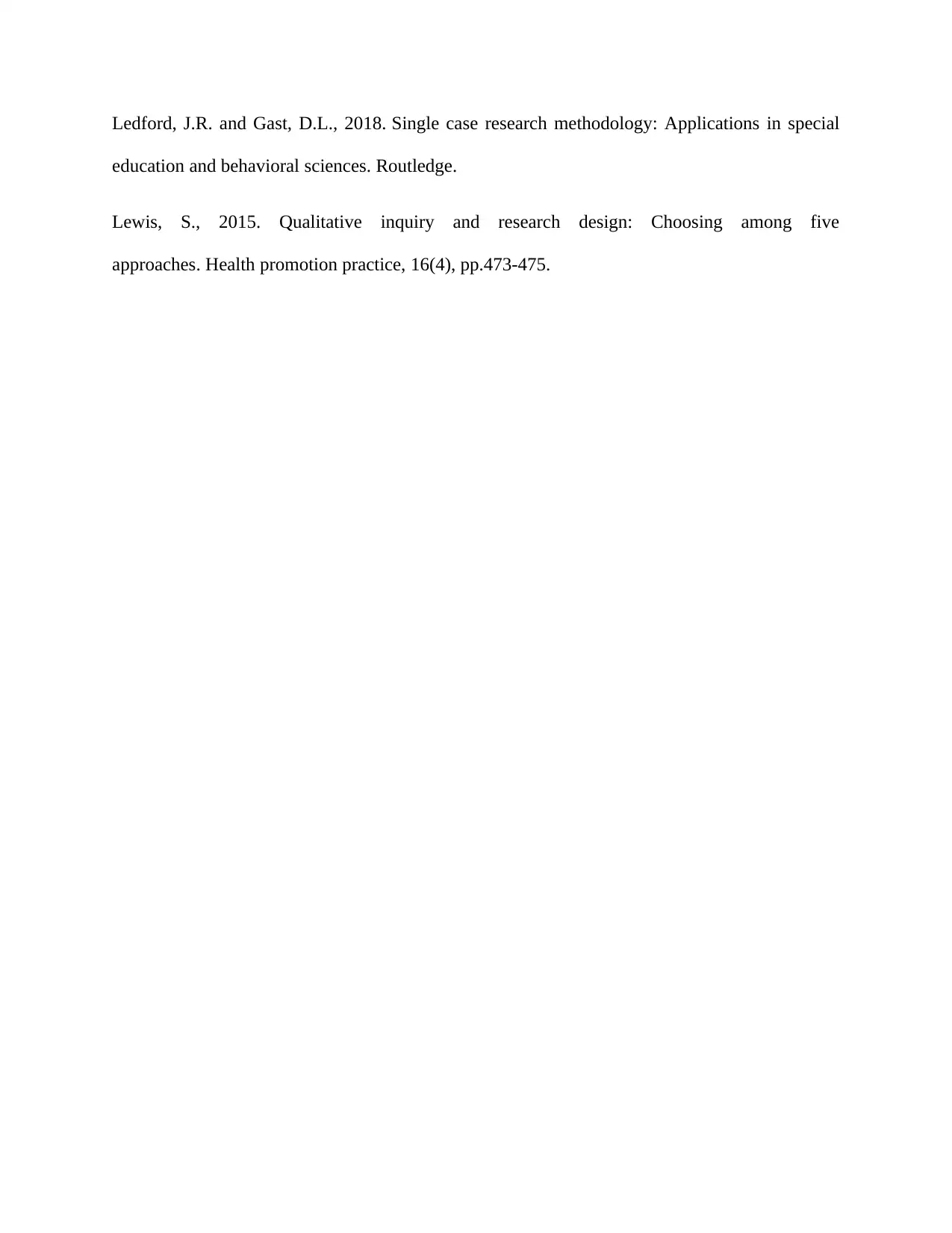
Ledford, J.R. and Gast, D.L., 2018. Single case research methodology: Applications in special
education and behavioral sciences. Routledge.
Lewis, S., 2015. Qualitative inquiry and research design: Choosing among five
approaches. Health promotion practice, 16(4), pp.473-475.
education and behavioral sciences. Routledge.
Lewis, S., 2015. Qualitative inquiry and research design: Choosing among five
approaches. Health promotion practice, 16(4), pp.473-475.
1 out of 8
Related Documents
Your All-in-One AI-Powered Toolkit for Academic Success.
+13062052269
info@desklib.com
Available 24*7 on WhatsApp / Email
![[object Object]](/_next/static/media/star-bottom.7253800d.svg)
Unlock your academic potential
Copyright © 2020–2025 A2Z Services. All Rights Reserved. Developed and managed by ZUCOL.




